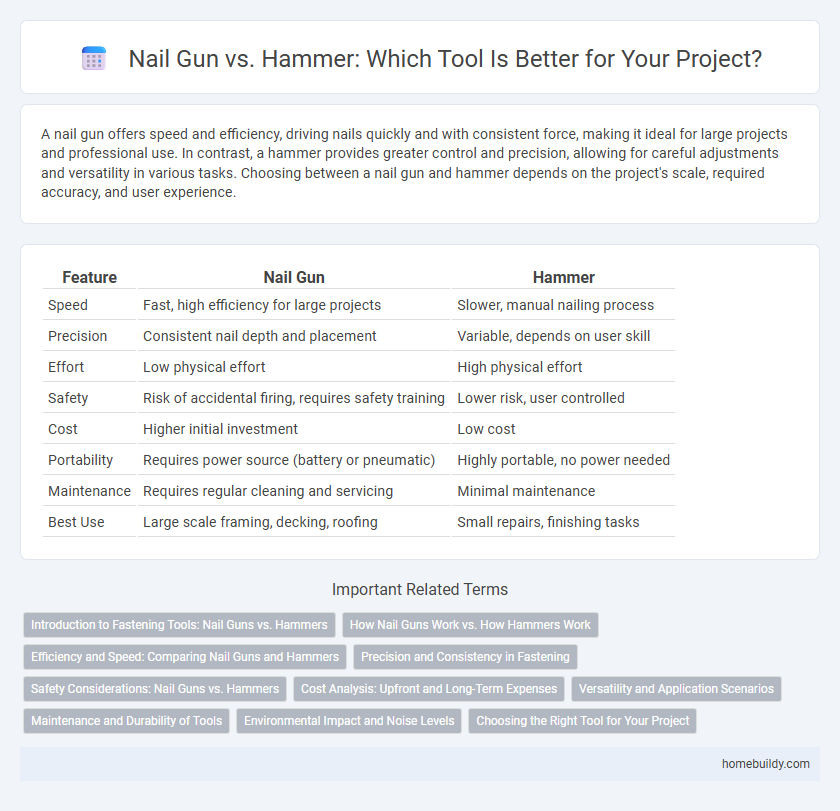A nail gun offers speed and efficiency, driving nails quickly and with consistent force, making it ideal for large projects and professional use. In contrast, a hammer provides greater control and precision, allowing for careful adjustments and versatility in various tasks. Choosing between a nail gun and hammer depends on the project's scale, required accuracy, and user experience.
Table of Comparison
| Feature | Nail Gun | Hammer |
|---|---|---|
| Speed | Fast, high efficiency for large projects | Slower, manual nailing process |
| Precision | Consistent nail depth and placement | Variable, depends on user skill |
| Effort | Low physical effort | High physical effort |
| Safety | Risk of accidental firing, requires safety training | Lower risk, user controlled |
| Cost | Higher initial investment | Low cost |
| Portability | Requires power source (battery or pneumatic) | Highly portable, no power needed |
| Maintenance | Requires regular cleaning and servicing | Minimal maintenance |
| Best Use | Large scale framing, decking, roofing | Small repairs, finishing tasks |
Introduction to Fastening Tools: Nail Guns vs. Hammers
Nail guns offer faster and more consistent fastening compared to traditional hammers, reducing manual effort and increasing productivity on construction sites. Hammers provide greater control and versatility for varied nailing tasks, especially in tight or delicate spaces where precision is crucial. Choosing between nail guns and hammers depends on project scale, speed requirements, and user skill level for optimal fastening results.
How Nail Guns Work vs. How Hammers Work
Nail guns operate using compressed air, electricity, or combustion to drive nails rapidly into materials, enabling high-speed, consistent fastening with minimal effort. Hammers rely on manual force, where the user swings the tool to deliver impact, requiring physical strength and precision for effective nail driving. The mechanized action of nail guns increases efficiency for large projects, while hammers offer greater control for delicate or detailed work.
Efficiency and Speed: Comparing Nail Guns and Hammers
Nail guns dramatically increase fastening efficiency and speed by driving nails in milliseconds, compared to the manual effort required with hammers. They reduce user fatigue and ensure consistent nail depth, enhancing productivity on large-scale construction projects. While hammers offer precision for delicate tasks, nail guns dominate in applications demanding rapid, repetitive nailing.
Precision and Consistency in Fastening
Nail guns deliver superior precision and consistency in fastening by driving nails at a uniform depth with each shot, reducing errors common in manual hammering. The controlled shooting mechanism ensures nails are placed accurately, minimizing surface damage and misalignment. This reliability enhances efficiency in construction and woodworking projects where exact fastening is critical.
Safety Considerations: Nail Guns vs. Hammers
Nail guns pose higher safety risks compared to hammers due to their rapid-fire mechanism, increasing the chances of accidental discharge and serious injuries. Proper training, use of safety goggles, and adherence to manufacturer guidelines significantly reduce nail gun accidents. Hammers, while generally safer, can cause repetitive strain injuries and bruises, highlighting the need for controlled use and protective gloves.
Cost Analysis: Upfront and Long-Term Expenses
Nail guns require a higher upfront investment, typically ranging from $100 to $200, compared to hammers which can cost as little as $10 to $50. Over time, nail guns reduce labor costs and increase efficiency, especially in large-scale projects, lowering overall expenses despite initial costs. Hammer use involves minimal maintenance and no power source expense, making it economically advantageous for small tasks but less cost-effective for high-volume work.
Versatility and Application Scenarios
Nail guns offer superior versatility by enabling rapid, consistent fastening in various materials such as wood, drywall, and metal, making them ideal for large-scale construction and framing tasks. Hammers provide greater precision and control for small projects, finishing nails, and delicate applications where manual adjustments are crucial. Each tool suits different application scenarios: nail guns excel in high-volume, repetitive work, while hammers remain essential for detailed carpentry and repair jobs.
Maintenance and Durability of Tools
Nail guns require regular maintenance such as lubrication and air filter cleaning to ensure consistent performance and longevity, while hammers demand minimal upkeep, primarily focusing on handle integrity and rust prevention. The durability of nail guns depends on proper care of mechanical parts and pneumatic components, which can wear out or malfunction if neglected. Hammers, constructed from solid steel and wood or fiberglass handles, often endure longer under heavy use without needing frequent repairs or replacements.
Environmental Impact and Noise Levels
Nail guns significantly reduce environmental impact by minimizing physical waste and increasing efficiency compared to traditional hammers, which often result in more bent or damaged nails. Noise levels produced by nail guns can exceed 100 decibels, posing a risk for hearing damage without proper protection, whereas hammers generate lower noise levels typically around 90 decibels. Choosing between the two tools depends on balancing the environmental benefits of nail guns with the need for noise management on job sites.
Choosing the Right Tool for Your Project
Selecting between a nail gun and a hammer depends on project scale, precision requirements, and material type. Nail guns offer speed and consistency for large tasks or repetitive nailing, significantly reducing labor time compared to traditional hammering. Hammers provide greater control and are ideal for small-scale projects, delicate work, or areas where power tools are impractical or unavailable.
nail gun vs hammer Infographic

 homebuildy.com
homebuildy.com